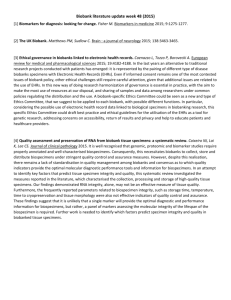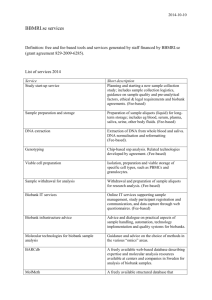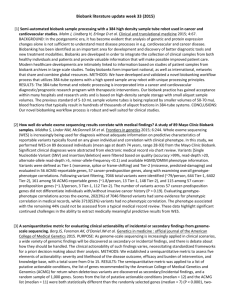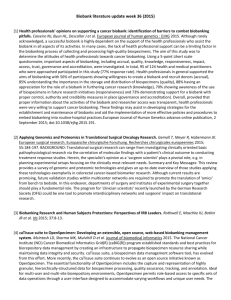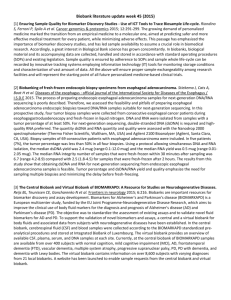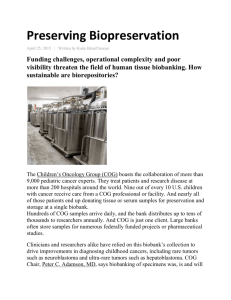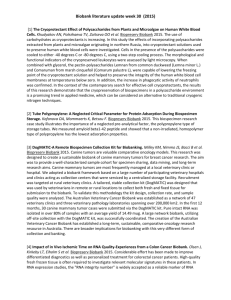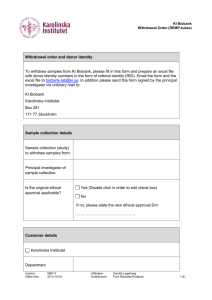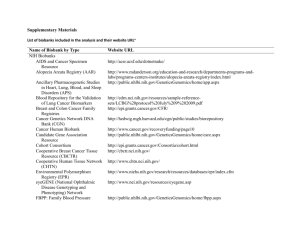a. Health benefits for research participants or donor
advertisement
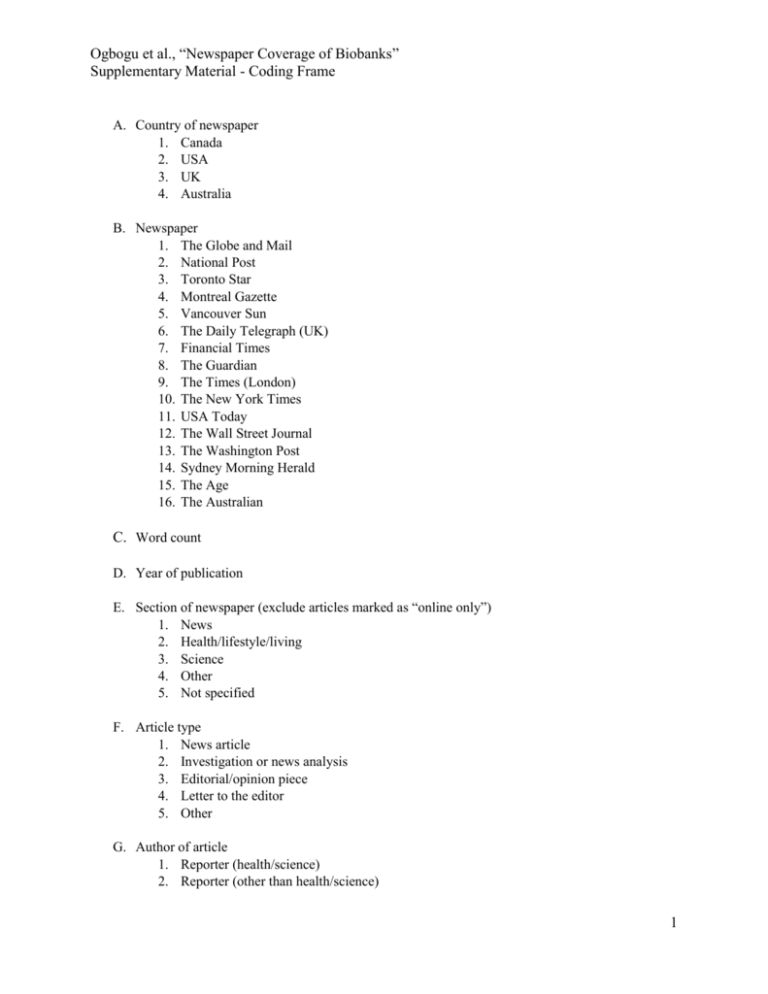
Ogbogu et al., “Newspaper Coverage of Biobanks” Supplementary Material - Coding Frame A. Country of newspaper 1. Canada 2. USA 3. UK 4. Australia B. Newspaper 1. The Globe and Mail 2. National Post 3. Toronto Star 4. Montreal Gazette 5. Vancouver Sun 6. The Daily Telegraph (UK) 7. Financial Times 8. The Guardian 9. The Times (London) 10. The New York Times 11. USA Today 12. The Wall Street Journal 13. The Washington Post 14. Sydney Morning Herald 15. The Age 16. The Australian C. Word count D. Year of publication E. Section of newspaper (exclude articles marked as “online only”) 1. News 2. Health/lifestyle/living 3. Science 4. Other 5. Not specified F. Article type 1. News article 2. Investigation or news analysis 3. Editorial/opinion piece 4. Letter to the editor 5. Other G. Author of article 1. Reporter (health/science) 2. Reporter (other than health/science) 1 Ogbogu et al., “Newspaper Coverage of Biobanks” Supplementary Material - Coding Frame 3. 4. 5. 6. Expert commentary Mixed/multiple authors Not specified Other (including letters to editor) H. Is a specific biobank mentioned? 1. No 2. Yes I. If so, what biobank is mentioned? (free code) 1. Not applicable 2. CARTaGene 3. Swedish Twin Registry 4. UK BioBank 5. Victorian Cancer Biobank 6. Childhood Cancer and Blood Research (CCBR) BioBank 7. Swedish National Biobank Program 8. Canadian Prostate Cancer Network (CPC GENE) BioBank 9. Newborn Screening Biobank (Denmark) 10. The National Cohort (German) 11. Children’s Hospital Boston Biobank 12. DeCODE 13. Denmark’s Biobank 14. Kaiser Permanente's Biobank 15. King’s College London Brain Bank 16. UK Brain Bank for Autism 17. Personal Genome Project 18. Cell Care 19. Donor Tissue Bank of Victoria 20. Harvard Brain Tissue Resource Center 21. UK Stem Cell Bank 22. Military Brain Injury Studies Program 23. Australian Breast Cancer Tissue Bank 24. Melanoma Institute’s Tissue Bank 25. Centre for the Study of Traumatic Encephalopathy at Boston University (“NFL’s brain bank”) 26. Breast Cancer Campaign’s Biobank 27. Quebec Brain Bank 28. Vanderbilt Medical Center Gene Bank 29. Stem Cell Bank at the Bernard O'Brien Institute of Microsurgery 30. Parkinson’s Disease Society Tissue Bank 31. Canadian Sports Concussion Project 32. Multiple (West London Mental Health NHS Trust Brain Bank; University of California Brain Observatory, Biobank Japan, Estonian Genome Project, Western Australia Genome Health Project, Singapore Tissue Network, UK Biobank (x2), CARTaGENE, BC Biolibrary, Breakthrough Generations project) 33. Genetic Alliance Biobank 2 Ogbogu et al., “Newspaper Coverage of Biobanks” Supplementary Material - Coding Frame 34. 35. 36. 37. 38. 39. 40. 41. 42. 43. 44. 45. 46. 47. SeraCare Biobank GRAD Biobank CollaGenesis Biobank Sydney Cord Blood Bank MS Brain Bank Comprehensive Human Tissue Network Tumor Tissue Repository StemLifeLine Tissue Bank Alberta Cord Blood Bank Virgin Health Bank LifeBankUSA Stem Cell Resource Cryos International Sperm Bank Baker Heart Research Institute Gene Bank J. Where is the biobank mentioned in the article located? 1. Not applicable 2. Canada 3. USA 4. UK 5. Australia 6. Other (specify; add separate code if 5 or more occurrences) K. What, if any, is the primary biological material represented in the article? 1. Blood 2. Tissue 3. Stem cells 4. Tumors 5. DNA 6. Sperm 7. Multiple (specify) (up to 3) 8. Unspecified 9. Urine 10. Saliva 11. Bone marrow 12. Amniotic Fluid 13. Embryos 14. Cheek Swab L. If mentioned, is the funding source for the biobank represented as public or private? 1. Public 2. Private 3. Joint 4. Unspecified M. If a specific source of funding is mentioned in the article, what is it? (develop code) 1. No source mentioned 3 Ogbogu et al., “Newspaper Coverage of Biobanks” Supplementary Material - Coding Frame 2. 3. 4. 5. 6. 7. 8. 9. 10. 11. 12. 13. 14. 15. 16. 17. 18. 19. 20. 21. 22. 23. 24. 25. 26. 27. 28. 29. 30. 31. 32. 33. 34. 35. 36. 37. 38. 39. 40. 41. 42. 43. 44. 45. 46. 47. Multiple (specify) (up to 3) CN Miracle Match Lawrence Zimmering (charitable fundraising) US Government Asterand (a company) UK Department of Health PROCURE Foundation (non-profit) Wellcome Trust Kaiser Permanente Medical Research Council Multiple Myeloma Research Consortium Private Volunteers Cell care Australian Government “Open source” (anyone able to purchase) US Pentagon National Health and Medical Research Council [Australia] The National Football League The Fonds de recherche en santé du Quebec Parkinson’s Disease Society Government of Sweden International Science Foundations UK Government Charitable funding Prostate Cancer Canada Ontario Institute for Cancer Research Movember Helmholtz Association (Germany’s largest research organization) German federal government German state governments Children’s Hospital Boston Donations Genome Canada Genome Quebec Breast cancer campaign Asda’s Tickled Pink Walk the Walk Campaign Centre for the Study of Traumatic Encephalopathy at Boston Sports Legacy Institute (a non-profit) Multiple (UK Department of Health, the Scottish Executive, the Northwest, federal government, Quebec government, international partners Pioneer Fund CIHR Department of Health Carnegie Fund II BioLevier National Health Service 4 Ogbogu et al., “Newspaper Coverage of Biobanks” Supplementary Material - Coding Frame 48. 49. 50. 51. 52. 53. 54. MS Research Australia National Institutes of Health BC Cancer Agency AstraZeneca Glaxo SmithKline Virgin Group City of London N. Does the article feature a patient/donor story? 1. No 2. Yes 3. O. What is (are) the condition(s)/disease(s) represented in the article? (develop code) 1. No specific condition mentioned 2. Mixed (specify as words) 3. Cancer 4. Schizophrenia 5. Autism 6. Dementia 7. Diabetes 8. Neurological disease 9. Alzheimer’s 10. Stroke 11. Chronic Traumatic Encephalopathy (CTE) 12. Staph infections (looking for genetic susceptibility to staph) 13. Brain injury 14. Parkinson’s 15. Multiple Sclerosis 16. Progeria 17. ALS 18. Chronic fatigue syndrome P. Were any of the following quoted in the discussion of biobanking? 1 = no, 2 = yes a. Patient/donor b. Researcher c. Clinician d. Public/government official e. Biobank staff f. Funding official g. Private industry Q. Are benefits of biobanking mentioned in the article? 1. No 2. Yes R. If so, how is the benefit framed? (Choose only the dominant frame.) 1. Clinical (immediate health benefits) 5 Ogbogu et al., “Newspaper Coverage of Biobanks” Supplementary Material - Coding Frame 2. 3. 4. 5. 6. Research and development Economic Progress and prestige Other (specify) Not applicable S. What is the main benefit discussed, if any? 1. Not applicable 2. Medical research 3. Contributes to Innovation 4. Useful for developing personalized medicine 5. Useful clinical information for donor/patient 6. Financial pay-offs/good financial investment 7. Forefront of medical research and health care 8. Contributes to economic growth 9. Used in treatment/used in clinical trials 10. Developing drugs and therapies 11. Study of Disease 12. Prevention/diagnosis/treatment of disease 13. Screening for disease 14. Prestige 15. Better outcomes for transplantation 16. Tissue donation 17. Curing/eliminating disease 18. Source for rare tissue 19. Therapeutic transplantation 20. Ethical source for stem cells 21. Public source for stem cells T. Does the article mention or discuss the following specific benefit or risk? (1 for no, 2 for yes): a. Health benefits for research participants or donor, including diagnostic or screening benefits b. Discrimination in health insurance c. Discrimination in other contexts U. Are risks or concerns regarding biobanking mentioned in the article? 1. No 2. Yes V. If so, now are the risks or concerns framed? 1. Clinical 2. Ethical 3. Economic 4. Research 5. Other (specify) 6. Not applicable 6 Ogbogu et al., “Newspaper Coverage of Biobanks” Supplementary Material - Coding Frame W. What is the main risk or concern discussed, if any? (develop code) 1. Not applicable 2. Privacy 3. Exploitation 4. Not useful/ not effective/ won’t provide useful information 5. Research without informed consent 6. Bankruptcy (not economically viable) 7. Discrimination in employment 8. Lack of governance/standards/oversight 9. Genetic discrimination 10. Uncertainty about remit/application 11. Patenting genes by companies 12. Expensive 13. Safety of product, need for safety testing 14. Ethical issues associated with embryonic stem cells 15. Lack of clear scientific rationale 16. Ownership of tissue/research results 17. Lack of research utility 18. Lack of clinical utility 19. Cost/funding 20. Consent 21. Diverts funding from other research 22. Racial discrimination 23. Sourcing of stem cells (abortion, etc.) 24. Increases complexity of medical treatment 25. Commodification 26. Lack of control over what research is done with donated material X. How is biobanking portrayed in the article as a whole? 1. Neutrally 2. Positively 3. Negatively Y. If positive, why? 1. Clinical 2. Research and development 3. Economic 4. Progress and prestige 5. Other (specify) 6. Not applicable Z. If negative, why? 1. Clinical 2. Ethical 3. Economic 4. Research 5. Other (specify) 7 Ogbogu et al., “Newspaper Coverage of Biobanks” Supplementary Material - Coding Frame 6. Not applicable AA. Are legal, policy, or regulatory issues relating to biobanking mentioned? 1. No 2. Yes 8
